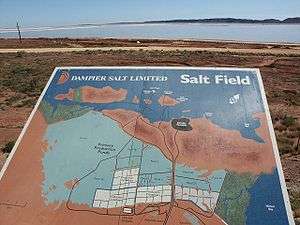Dampier, Western Australia
| Dampier Western Australia | |||||||
|---|---|---|---|---|---|---|---|
 Map of Dampier, Western Australia and surrounding area. | |||||||
 Dampier | |||||||
| Coordinates | 20°40′S 116°43′E / 20.66°S 116.71°ECoordinates: 20°40′S 116°43′E / 20.66°S 116.71°E | ||||||
| Population | 1,341 (2011 census)[1] | ||||||
| Established | 1965 | ||||||
| Postcode(s) | 6713 | ||||||
| Elevation | 0 m (0 ft) | ||||||
| Location | |||||||
| LGA(s) | City of Karratha | ||||||
| State electorate(s) | North West | ||||||
| Federal Division(s) | Durack | ||||||
| |||||||
Dampier is a major industrial port in the northwest of Western Australia. The Dampier Port is part of the Dampier Archipelago. The port services petrochemical, salt, iron ore and natural gas export industries. Rio Tinto exports large volumes of iron ore through the port, and in September 2010 announced plans to expand capacity.[2] At the 2011 census, Dampier had a population of 1,341.[1]
History

The Yaburrara Aboriginal tribe lived in the area for many thousands of years.[3]
The town derives its name from its location on Dampier Island, 3 km off the Pilbara coast and part of the Dampier Archipelago, both named after the English navigator William Dampier. In 1963 the island became an artificial peninsula when it was connected to the mainland by a causeway for a road and railway. In 1979 Dampier Peninsular was renamed after Mt Burrup, the highest peak on the island, which had been named after Henry Burrup, a Union Bank clerk murdered in 1885 at Roebourne.[4][5][6]
In 1699 Dampier, in command of the 26-gun warship HMS Roebuck on a mission to explore the coast of New Holland, following the Dutch route to the Indies, passed between Dirk Hartog Island and the Western Australian mainland into what he called Shark Bay. He then followed the coast northeast, on 21 August 1699 reaching the Dampier Archipelago, which he explored, naming Rosemary Island. He continued to Lagrange Bay, just south of what is now Roebuck Bay, before sailing for Timor.[7]
The town was built from 1965 onwards, to serve the railway transporting iron ore from Tom Price and Paraburdoo. By 1968, the further expansion of Dampier had been constrained by geographical factors and a new town of Karratha was established on the mainland as a result.[8]
Environment
The Burrup Peninsula, or Murujuga, which means "Hip Bone Sticking Out" in the Yaburrara language, is home to what is believed to be the largest collection of petroglyphs (ancient rock art) in the world.[3]
There are 42 other islands in the Dampier Archipelago.[9] There is a hugely diverse marine ecosystem around the islands, including whales, dugongs, turtles, coral and sponges. Green turtles, (Chelonia mydas) are known to nest in the Dampier Archipelago.[10][11]
Climate
Under the Köppen climate classification, Dampier has a desert climate (BWh).[12] The annual average rainfall is 272.2 millimetres (10.7 in), which would make it a semi-arid climate, except, like Alice Springs, its high evapotranspiration (or its aridity) makes it a desert climate. Dampier has extremely hot and humid summers with dewpoints exceeding 24 °C (75 °F). Having over 3,700 hours of annual sunshine, it is one of the sunniest places in Australia.
| Climate data for Dampier Salt | |||||||||||||
|---|---|---|---|---|---|---|---|---|---|---|---|---|---|
| Month | Jan | Feb | Mar | Apr | May | Jun | Jul | Aug | Sep | Oct | Nov | Dec | Year |
| Record high °C (°F) | 46.4 (115.5) |
47.1 (116.8) |
45.7 (114.3) |
42.2 (108) |
39.5 (103.1) |
32.5 (90.5) |
33.0 (91.4) |
37.3 (99.1) |
38.7 (101.7) |
43.2 (109.8) |
45.5 (113.9) |
46.5 (115.7) |
47.1 (116.8) |
| Average high °C (°F) | 35.9 (96.6) |
36.0 (96.8) |
36.2 (97.2) |
34.4 (93.9) |
29.9 (85.8) |
26.6 (79.9) |
26.2 (79.2) |
27.7 (81.9) |
30.5 (86.9) |
32.7 (90.9) |
34.3 (93.7) |
35.7 (96.3) |
32.2 (90) |
| Average low °C (°F) | 26.1 (79) |
26.5 (79.7) |
25.5 (77.9) |
22.8 (73) |
18.2 (64.8) |
15.1 (59.2) |
13.4 (56.1) |
14.6 (58.3) |
16.8 (62.2) |
19.7 (67.5) |
22.2 (72) |
24.6 (76.3) |
20.5 (68.9) |
| Record low °C (°F) | 17.5 (63.5) |
20.1 (68.2) |
20.0 (68) |
15.8 (60.4) |
10.4 (50.7) |
5.2 (41.4) |
4.6 (40.3) |
6.4 (43.5) |
8.6 (47.5) |
9.0 (48.2) |
11.4 (52.5) |
15.9 (60.6) |
4.6 (40.3) |
| Average precipitation mm (inches) | 36.3 (1.429) |
71.4 (2.811) |
46.7 (1.839) |
18.9 (0.744) |
31.0 (1.22) |
36.1 (1.421) |
11.7 (0.461) |
4.4 (0.173) |
1.5 (0.059) |
0.8 (0.031) |
1.4 (0.055) |
13.4 (0.528) |
272.8 (10.74) |
| Average precipitation days | 4.1 | 5.5 | 4.2 | 1.9 | 3.4 | 3.5 | 2.2 | 1.1 | 0.6 | 0.2 | 0.4 | 1.5 | 28.6 |
| Average relative humidity (%) | 50 | 51 | 44 | 37 | 38 | 40 | 35 | 35 | 32 | 37 | 41 | 45 | 40 |
| Mean monthly sunshine hours | 325.5 | 292.9 | 303.8 | 288.0 | 269.7 | 258.0 | 282.1 | 316.2 | 324.0 | 356.5 | 354.0 | 356.5 | 3,727.2 |
| Source: [13] | |||||||||||||
Attractions
At the entrance to the town is a statue of "Red Dog", a red kelpie/cattledog well known for roaming the area in the 1970s and hitching rides to nearby towns. The statue reads "Erected by the many friends made during his travels".[14] Other attractions include the fishing not far off the coast, the most commonly targeted species being barramundi (Lates calcarifer).
Port

The port of Dampier was opened in 1966, when the first iron ore from the Mount Tom Price mine was transported via the Hamersley & Robe River railway to Parker Point and loaded on ships. The port at East Intercourse Island opened in 1972.[15]
The port has an annual loading capacity of 140 million tonnes of iron ore. Rio Tinto's other iron ore port, Cape Lambert, can handle 80 million tonnes per year. It takes from 24 to 36 hours to load a ship at port.[15]
Photos
 Salt Field
Salt Field Iron Ore
Iron Ore "Red Dog" statue
"Red Dog" statue
Panoramas


References
- 1 2 Australian Bureau of Statistics (31 October 2012). "Dampier (Urban Centre/Locality)". 2011 Census QuickStats. Retrieved 9 July 2014.
- ↑ "Rio Tinto to boost Pilbara capacity - International Railway Journal". 2010-09-28. Retrieved 2010-09-28.
- 1 2 González Zarandona, José Antonio (2011). "The Destruction of Heritage: Rock Art in the Burrup Peninsula". International Journal of the Humanities. 9 (1): 328. ISSN 1447-9508.
- ↑ Kuhlenbeck, Britta (2009). "Politics of Space". Re-writing Spatiality: The Production of Space in the Pilbara Region in Western Australia. Hamburg: University of Hamburg. p. 154. ISBN 978-3-643-10980-4.
- ↑ Bednarik, Robert G. (May 2002). "The survival of the Murujuga (Burrup) petroglyphs". Rock Art Research: The Journal of the Australian Rock Art Research Association (AURA). Archaeological Publications. 19 (1): 29. ISSN 0813-0426.
- ↑ "Supreme Court - Criminal Sittings". The West Australian. Perth, WA. 2 July 1885. p. 3. Retrieved 27 July 2014.
- ↑ Burney, James (1816). "7. Voyage of Captain William Dampier, in the Roebuck, to New Holland". A Chronological History of the Discoveries in the South Sea or Pacific Ocean. 4. London: G. & W. Nicol, G. & J. Robinson & T. Payne. p. 399. Retrieved 9 Oct 2013.
- ↑ Dampier The Sydney Morning Herald. 8 February 2004. Retrieved 3 December 2006.
- ↑ Kuhlenbeck, Britta (2009). "Politics of Space". Re-writing Spatiality: The Production of Space in the Pilbara Region in Western Australia. Hamburg: University of Hamburg. p. 211. ISBN 978-3-643-10980-4.
- ↑ D-day for Dampier 19 December 2005. The Wilderness Society. Retrieved 3 December 2006.
- ↑ Marine turtles in Western Australia Department of Conservation and Land Management. Retrieved 4 March 2007.
- ↑ Tapper, Andrew; Tapper, Nigel (1996). Gray, Kathleen, ed. The weather and climate of Australia and New Zealand (First ed.). Melbourne, Australia: Oxford University Press. p. 300. ISBN 0-19-553393-3.
- ↑ "Climate statistics for Dampier Salt". Bureau of Meteorology. Retrieved January 25, 2015.
- ↑ Dog deserves a pat The West Australian. 12 October 2006. Retrieved 3 December 2006. Archived February 20, 2007, at the Wayback Machine.
- 1 2 Ports Rio Tinto Iron Ore website, accessed: 8 November 2010
External links
![]() Media related to Dampier, Western Australia at Wikimedia Commons
Media related to Dampier, Western Australia at Wikimedia Commons
- Dampier Port Authority
- The Burrup Peninsula The National Trust of Australia
- The World Monuments Fund's 2008 Watch List page for the Dampier Rock Art Complex
- Dampier Port Authority